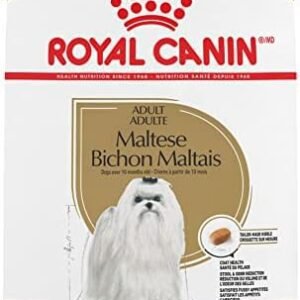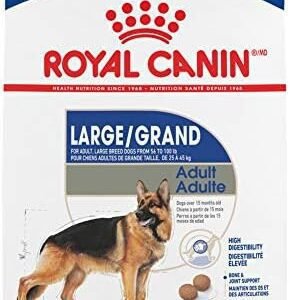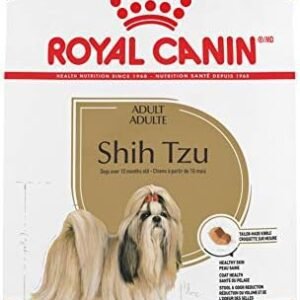The Scottish Terrier, often affectionately known as the “Scottie,” is a breed with a rich history and a distinct personality that has captured the hearts of dog enthusiasts worldwide. In this article, we will delve into the fascinating world of the Scottish Terrier, exploring what sets this breed apart and the importance of choosing the right canine companion that aligns with your lifestyle.
Did you know? Scottish Terriers are known for their distinctive appearance and unwavering loyalty.

Understanding the Scottish Terrier Breed
What distinguishes the Scottish Terrier from other breeds and what makes it a preferred choice for dog lovers? The Scottie’s unique characteristics and charming disposition make it stand out. These dogs are known for their distinctive appearance and robust temperament, which have made them popular in various roles, from loyal family pets to skilled hunters.
Selecting the right breed is a crucial decision when it comes to welcoming a four-legged friend into your home. Different dog breeds possess unique traits, temperaments, and exercise requirements. It’s essential to choose a breed that suits your lifestyle to ensure you can meet their needs adequately.
To provide a comprehensive overview of the Scottish Terrier breed, here is a table outlining key characteristics and information:
| Field | Information |
|---|---|
| Height | 10-11 inches |
| Weight | 18-22 pounds |
| Life Span | 11-13 years |
| Good with | Families, singles |
| Temperament | Independent, confident, alert |
| Intelligence | High |
| Shedding Amount | Low |
| Grooming | Moderate |
| Exercise Needs | Moderate |
| Energy Level | Moderate |
| Barking Level | Moderate |
| Drool Amount | Minimal |
| Coat Length/Texture | Double coat, wiry |
| Colors | Black, brindle, wheaten |
| Patterns | None |
The Scottish Terrier’s characteristics, as depicted in the table, highlight their suitability for various roles, from family companions to alert watchdogs. In the following sections, we will delve deeper into the Scottish Terrier’s physical appearance, personality, grooming requirements, exercise needs, and the roles in which they excel.
Table of Contents
Breed History and Origin
Exploring Their Roots
The Scottish Terrier’s history is a tale that winds its way through the hills and glens of Scotland. This resilient and spirited breed has its origins steeped in the Scottish countryside, and its development involved the contributions of several breeds that played a crucial role in shaping the Scottie’s character.
Early Terriers of Scotland
The Scottish Terrier shares its lineage with several other terrier breeds that called Scotland their home. These early terriers, including the Cairn Terrier and West Highland White Terrier, were bred for their tenacity and unwavering hunting instincts. They were essential for hunting small game, such as foxes and badgers, in the challenging Scottish terrain.
Aberdeen Terrier
One of the direct ancestors of the Scottish Terrier is the Aberdeen Terrier, which was a term used to describe terriers from the northeast of Scotland. This terrier contributed significantly to the Scottie’s development. They were known for their ruggedness and were often used in hunting foxes and otters.
Development of a Breed
Through selective breeding of these tenacious terriers, the Scottish Terrier gradually emerged as a distinct breed. The breeders aimed to create a dog that was an effective hunter, particularly of vermin, while being small enough to navigate the rugged Scottish terrain.
Notable Traits
The Scottish Terrier’s history is not just a reflection of its hunting prowess but also its distinctive traits:
Independent Nature: The Scottie’s early role as a hunter of small game in challenging terrains required an independent spirit. This trait has remained with the breed, and Scotties are often known for their self-reliance.
Iconic Appearance: The Scottie’s appearance, with its wiry double coat and distinctive beard, is an iconic feature that has been cherished for centuries. This appearance was well-suited for braving the Scottish weather.
Fearless Hunter: In their role as hunters, Scottish Terriers were fearless and determined. They were known for their ability to pursue their quarry without hesitation, despite their smaller size.
- Loyal Companions: While they were initially bred for hunting, Scotties quickly became beloved companions. Their loyalty and watchful nature made them excellent family dogs.
Relevance of Origin
Understanding the Scottish Terrier’s origins is essential for appreciating its unique traits and temperament. The breed’s historical development involved the selective breeding of terriers with distinct characteristics to create an efficient hunter and a loyal family pet.
The Scottie’s independent nature, iconic appearance, and fearless hunting ability continue to influence its role as a companion today. Their strong-willed and confident character is part of their charm, and it’s essential to understand their historical roots to appreciate their distinct qualities fully.
In the upcoming sections, we will delve deeper into the Scottish Terrier’s physical appearance, personality, grooming requirements, exercise needs, and the roles in which they excel, providing you with a comprehensive understanding of this remarkable breed.
- Physical Characteristics:
• Size and build: Describe the Scottish Terrier’s size, body structure, and distinctive physical features.
• Head and expression: Detail the breed’s head characteristics, including its expression, ears, and eyes.
• Coat and color: Explain the Scottish Terrier’s coat texture, color, and grooming needs.
• Sturdy legs and paws: Discuss the breed’s legs, paws, and their significance in its hunting prowess.
• Tail and posture: Describe the breed’s tail, posture, and how it carries itself while on the hunt.
Understanding the Scottish Terrier Breed’s Traits
Physical Characteristics
The Scottish Terrier boasts a distinctive and eye-catching appearance. Understanding their physical attributes is essential to appreciate their unique charm.

Size and Build:
The Scottie is a small breed, with males typically standing 10-11 inches at the shoulder, and females slightly smaller. Despite their small size, they are well-built and robust, showcasing a sturdy and muscular frame. Their compact size made them agile and suitable for hunting in the rugged Scottish landscape.
Head and Expression:
One of the most iconic features of the Scottish Terrier is its head, which displays a dignified and alert expression. Their head is well-proportioned to their body and features a bushy beard and mustache, which are characteristic of the breed. Their ears stand erect, adding to their attentive look, and their eyes are almond-shaped and dark brown, conveying an expression of intelligence and confidence.
Coat and Color:
The Scottie’s coat is a double coat, featuring a soft, dense undercoat and a wiry, straight topcoat. This combination provides insulation and protection against the Scottish weather. They come in various colors, including black, brindle (a striped pattern), and wheaten (pale yellowish-white). The distinctive coat and color variations add to their unique charm.
Sturdy Legs and Paws:
Scottish Terriers have strong and straight legs that provide them with stability and agility. Their paws are round and compact, with well-arched toes. These features enable them to traverse uneven terrain with ease, a quality that was essential for their hunting roles.
Tail and Posture:
The Scottie’s tail is erect, short, and carries a slight curve. It adds to their confident and poised posture. Their overall stance and bearing exude a sense of self-assuredness, reflecting their original role as tenacious hunters.
Temperament Overview
Scottish Terriers have a unique temperament that has earned them a dedicated fan base. Understanding their disposition and suitability as family pets is crucial.
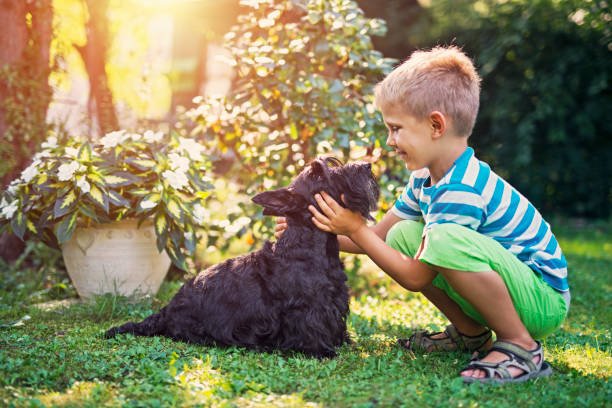
The Scottie’s temperament can be summarized as follows:
Independent: Scottish Terriers are known for their independent nature. They don’t require constant attention and are content spending time alone. This trait can be an advantage, especially for individuals or families with busy lifestyles.
Confident: Despite their small stature, Scotties are incredibly confident. They have a fearless disposition and won’t back down from challenges, which is a trait that originated from their hunting days.
Alert: These dogs are naturally alert and make excellent watchdogs. They have a keen sense of their surroundings and will readily announce the presence of strangers.
Loyal and Loving: While they may appear aloof at times, Scottish Terriers are deeply loyal to their families. They form strong bonds and are known to be loving and protective. They often get along well with children, making them a suitable choice for families.
Compatibility with Other Pets: Scotties can coexist with other pets, including other dogs. However, their strong hunting instincts may lead to occasional chasing of smaller animals, so supervision is recommended.
Environmental Needs
Scottish Terriers can adapt well to various environments, but there are specific considerations to keep in mind:
Space: While they are small, Scotties are active dogs that require some space to move around. Regular exercise in a secure yard or on daily walks is essential to keep them happy.
Temperature: Their double coat provides insulation, but they may be sensitive to extreme heat. It’s crucial to provide shade and water during hot weather.
Living Arrangements: Scottish Terriers can thrive in both apartments and houses, as long as they receive the necessary exercise and mental stimulation. They are adaptable but still require daily physical and mental challenges to prevent boredom.
Common Behavioral Traits
Scottish Terriers have a range of behavioral traits that can make them wonderful companions but also require proper management:
Stubbornness: The same independent nature that makes them confident can also lead to stubbornness. Training may require patience and consistency.
Barking: They are known for their alertness and may bark at perceived threats or unfamiliar sounds. Proper training can help manage excessive barking.
Digging: Scotties have a strong hunting instinct, and this may manifest as digging. Providing them with appropriate outlets for this behavior, such as toys or designated digging areas, can help prevent unwanted digging in the yard.
- Protectiveness: They are loyal and protective of their families. Socialization from a young age can help them distinguish between real threats and regular interactions.
Understanding these traits and knowing how to address them will ensure a harmonious relationship with your Scottish Terrier. In the upcoming sections, we will explore grooming requirements, exercise needs, and the roles in which they excel, providing you with a comprehensive understanding of this remarkable breed.
Popularity and Recognition
Current Popularity
The Scottish Terrier, or “Scottie,” has maintained a steady and enduring popularity over the years. Known for their distinctive appearance and unwavering loyalty, Scotties continue to capture the hearts of dog enthusiasts worldwide. While they may not always be at the top of the popularity charts, they enjoy a dedicated and passionate fan base.
The popularity of Scottish Terriers today can be attributed to several factors:
Unique Appearance: The Scottie’s iconic appearance, with a wiry double coat, distinctive beard, and erect ears, sets them apart. Their dignified and alert expression adds to their charm, making them instantly recognizable.
Loyal Nature: Scottish Terriers are renowned for their loyalty and devotion to their families. Their watchful and protective nature makes them excellent companions, particularly in family settings.
Versatility: Scotties are adaptable and can thrive in various living conditions, from apartments to houses with yards. Their moderate exercise needs make them suitable for individuals and families with different lifestyles.
Historical Significance: The breed’s rich history and its association with Scottish heritage contribute to its appeal. Many dog enthusiasts are drawn to their connection to Scottish culture and traditions.
Resilience: The Scottish Terrier’s history as a fearless hunter in challenging terrains has left a lasting impression on their character. Their independent and confident nature continues to attract those who appreciate these qualities in a canine companion.
While trends in dog ownership may come and go, the Scottish Terrier’s enduring popularity can be attributed to their unique combination of traits, making them a beloved breed for those who understand and appreciate their distinctive qualities.
Breed Recognition
The Scottish Terrier is a well-recognized breed, and their distinctive appearance and charming personality have not gone unnoticed by kennel clubs and breed organizations. They have received recognition and accolades that acknowledge their importance in the world of purebred dogs.
Notable kennel clubs and breed organizations that recognize and support the Scottish Terrier include:
The American Kennel Club (AKC): The AKC, one of the most prominent kennel clubs in the United States, recognizes the Scottish Terrier as a breed. They are classified as a member of the Terrier Group.
The Kennel Club (UK): In the United Kingdom, the Scottish Terrier is recognized by The Kennel Club. Here, they are part of the Terrier Group, a classification that acknowledges their heritage as tenacious terriers.
Scottish Terrier Club of America (STCA): This breed-specific organization is dedicated to the Scottish Terrier and is affiliated with the AKC. The STCA plays a vital role in promoting the breed and providing resources and support for Scottie enthusiasts.
- National Breed Clubs: In addition to the STCA, there are national breed clubs in various countries that focus on the welfare and promotion of the Scottish Terrier. These clubs contribute to breed preservation and education about the breed.
Notable Breed Varieties
While Scottish Terriers are generally a distinctive breed with a consistent appearance and temperament, there may be slight variations or preferences in different regions. Notable breed varieties or subtypes of Scottish Terriers can include:
American Scottish Terrier: This variety may refer to Scottish Terriers bred in the United States. They typically share the breed’s iconic traits but may exhibit subtle differences in conformation or grooming preferences. American Scotties remain loyal and confident.
English Scottish Terrier: While the term “English” is not commonly used to describe Scottish Terriers, it can refer to Scotties bred in the United Kingdom. These dogs uphold the traditional Scottish Terrier characteristics, including their independent and alert nature.
International Lines: Scotties bred in different countries may have unique lineage, but their core breed characteristics are consistent. The preferences and breeding practices of specific regions may influence variations in appearance or temperament.
It’s important to note that these variations are relatively subtle and don’t represent distinct subtypes of Scottish Terriers. The breed’s standard characteristics, such as their appearance and temperament, remain consistent and are upheld by kennel clubs and breed organizations.
In the upcoming sections, we will continue to explore various aspects of the Scottish Terrier breed, including grooming and maintenance, exercise and playtime, and their historical and contemporary roles. This comprehensive information will provide you with a thorough understanding of this remarkable canine companion.
Health Considerations and Care
Taking care of your Scottish Terrier’s health is essential to ensure a long, happy, and active life for your furry friend. In this section, we’ll discuss common health issues that the breed may be prone to and provide insights into their average lifespan and tips for promoting a longer and healthier life.
Common Health Issues
While Scottish Terriers are generally hardy and robust dogs, like all breeds, they can be prone to specific health issues. Being aware of these common concerns and taking proactive measures can help ensure your Scottie’s well-being. Some of the health issues that are frequently seen in Scottish Terriers include:
Scottie Cramp: This condition is characterized by muscle spasms and hyperextension of the limbs, typically occurring during moments of excitement or stress. It is a genetic disorder and can be managed with the guidance of a veterinarian.
Von Willebrand’s Disease: Scotties may be susceptible to this inherited bleeding disorder. It can cause excessive bleeding due to a deficiency in a clotting protein. Your veterinarian can perform tests to diagnose this condition.
Patellar Luxation: Patellar luxation, or dislocated kneecaps, is a condition where the kneecap moves out of its normal position. It can cause lameness or an abnormal gait and may require surgery in severe cases.
Bladder Cancer: Unfortunately, Scottish Terriers have a higher risk of developing bladder cancer compared to some other breeds. Regular veterinary check-ups are crucial to detect this condition early.
Craniomandibular Osteopathy (CMO): CMO is a condition that affects the growth of bones in the skull and jaw. It can lead to discomfort and difficulty eating. Early detection and appropriate management are essential.
Flea Allergies: Scottish Terriers may be sensitive to fleas and develop allergic reactions when bitten. Regular flea prevention is important to avoid skin issues and discomfort.
Hypothyroidism: Some Scotties can experience an underactive thyroid gland, leading to weight gain, lethargy, and skin problems. Thyroid replacement therapy can manage this condition.
Cancer: Like many other breeds, Scottish Terriers are susceptible to various types of cancer. Early detection and a healthy lifestyle can help reduce the risk.
Gastric Torsion (Bloat): Bloat is a severe and life-threatening condition that can affect deep-chested breeds like Scotties. It involves the stomach twisting, leading to a blockage in blood flow and digestion. Feeding smaller, more frequent meals and avoiding strenuous exercise after eating can help prevent bloat.
It’s important to note that not all Scottish Terriers will experience these health issues, but it’s essential to be aware of the potential risks and take preventive measures. Regular check-ups with your veterinarian are crucial to monitor your Scottie’s health and catch any issues early.
Lifespan and Longevity
The average lifespan of a Scottish Terrier is typically between 11 and 13 years. Proper care, a balanced diet, regular exercise, and regular veterinary check-ups can contribute to a longer and healthier life for your Scottie.
To promote a longer and healthier life for your Scottish Terrier, consider the following tips:
Balanced Diet: Feed your Scottie a high-quality dog food that meets their specific nutritional needs. Avoid overfeeding, as obesity can lead to various health problems.
Regular Exercise: Scottish Terriers are moderately active dogs. Daily walks, playtime, and mental stimulation are essential to keep them fit and happy. Exercise also helps prevent obesity.
Regular Veterinary Check-ups: Schedule regular check-ups with your veterinarian to monitor your Scottie’s health. This is crucial for early detection and prevention of potential health issues.
Dental Care: Maintain good oral hygiene by regularly brushing your Scottie’s teeth and providing dental chews or toys. Dental problems can lead to more significant health issues if left untreated.
Parasite Prevention: Use preventative measures to protect your dog from fleas, ticks, and heartworms. Parasite-borne diseases can be serious and are best avoided through regular prevention.
Grooming: Proper grooming, including brushing and stripping the coat, helps maintain your Scottie’s skin and coat health. Regular grooming also allows you to inspect your dog for any abnormalities.
A Stress-Free Environment: Minimize stress and anxiety in your Scottie’s life. These dogs thrive in a calm and loving environment. Socialization and positive training methods are essential.
Quality Time: Spend quality time with your Scottish Terrier. Their loyalty and love for their families mean that they thrive on companionship and attention.
Remember that every dog is an individual, and genetics play a role in their health. Regular communication with your veterinarian is key to addressing any specific health concerns and ensuring your Scottie’s well-being.
By following these guidelines and being attentive to your Scottish Terrier’s needs, you can help them lead a long, happy, and healthy life as your faithful and beloved companion.
In the following section, we will delve into exercise and playtime for your Scottish Terrier, providing you with insights into their daily activity requirements and fun activities to keep them engaged and content.
Exercise and Activity Recommendations for Scottish Terriers
Scottish Terriers, with their compact yet robust build, have specific exercise requirements that are essential for maintaining their physical and mental well-being. In this section, we will provide a detailed exercise plan, addressing the types of exercise, duration, and frequency that are ideal for your Scottish Terrier.
Daily Exercise Needs

Scottish Terriers are moderately active dogs that benefit from daily exercise to stay happy and healthy. While they are not as high-energy as some other breeds, they still require regular physical and mental stimulation. Here’s a breakdown of their daily exercise needs:
Walks: Daily walks are essential to meet your Scottie’s exercise requirements. A brisk 20 to 30-minute walk each day can help them burn off energy and enjoy some outdoor time. Walks are also an excellent opportunity for socialization.
Playtime: Scotties enjoy playtime with their owners. Engage in interactive games like fetch, tug-of-war, or hide and seek. These activities provide mental stimulation as well as physical exercise.
Mental Stimulation: In addition to physical exercise, it’s crucial to challenge your Scottie’s mind. Puzzle toys, treat-dispensing toys, and obedience training can keep their brains active.
Socialization: Scottish Terriers can be a bit reserved with strangers, so early and ongoing socialization is essential. Regular interactions with other dogs and people help them develop good social skills.
Agility Training: If you’re interested in taking your Scottie’s exercise to the next level, consider agility training. This activity provides both physical and mental stimulation and can be a fun way to bond with your dog.
Hunting Instinct: Some Scotties retain a strong hunting instinct. Engaging in activities that allow them to pursue toys or engage with scent trails can tap into this natural drive.
- Quality Time: Your Scottie loves spending quality time with you. Simply being together, whether it’s a gentle grooming session or relaxing on the couch, is an essential part of their daily routine.
Exercise Duration and Frequency
To keep your Scottish Terrier physically and mentally satisfied, follow this exercise plan:
Daily Walks: Take your Scottie for a 20 to 30-minute walk each day. These walks help with physical activity and provide opportunities for mental stimulation through various scents and interactions.
Playtime: Spend about 15 to 30 minutes engaging in interactive play sessions. Activities like fetch, tug-of-war, and hide and seek are great choices.
Mental Stimulation: Dedicate 15 to 20 minutes to mental exercises, such as obedience training or interactive puzzle toys.
Socialization: Regular socialization is vital, so aim for brief but frequent interactions with other dogs and people.
Agility Training: If you decide to incorporate agility training, engage in sessions lasting 15 to 20 minutes a few times a week. Agility can be both physically and mentally demanding for your Scottie.
Hunting Instinct Activities: If your Scottie has a strong hunting instinct, consider dedicating 10 to 15 minutes to scent-based games or toys designed to satisfy their natural drive.
- Quality Time: Spend quality time with your Scottie every day, whether it’s cuddling, grooming, or merely being present. This connection is essential for their well-being.
While the above recommendations offer a general guideline for exercise, it’s essential to adjust them based on your individual Scottie’s energy level, age, and health. Some dogs may need more exercise, while others may require less. Pay attention to your Scottie’s cues and adjust their exercise routine accordingly.
Breed-Specific Exercise Considerations
Scottish Terriers have specific breed traits that can influence their exercise needs:
Strong Hunting Instinct: Many Scotties have a strong hunting instinct, so activities that mimic hunting behaviors can be particularly engaging for them. Hide and seek games or puzzle toys that challenge their problem-solving skills are excellent choices.
Independent Nature: Due to their independence, Scotties may be content with self-directed play in a secure backyard. However, they should never be left alone for extended periods. They still need social interaction and engagement.
Weather Sensitivity: The Scottie’s double coat provides insulation, but they may be sensitive to extreme heat. Be mindful of the weather and adjust exercise accordingly. During hot weather, opt for cooler times of the day for outdoor activities.
Moderate Energy Level: While they have a strong spirit, Scottish Terriers are not hyperactive dogs. They have a moderate energy level, which makes them adaptable to various lifestyles. Regular, consistent exercise is more important than intense workouts.
Physical Limitations: As Scotties age, they may develop physical limitations. Adjust their exercise routines to accommodate their changing needs. Swimming, for instance, can be an excellent low-impact exercise for senior Scotties.
Benefits of Exercise
Regular exercise offers numerous benefits to Scottish Terriers, including:
Physical Health: Exercise helps maintain a healthy weight, prevents obesity, and supports cardiovascular health.
Mental Stimulation: Engaging in various activities keeps their minds active, preventing boredom and destructive behaviors.
Socialization: Regular interactions with other dogs and people help improve social skills and reduce fear of strangers.
Strong Bond: Spending time together during exercise and playtime strengthens the bond between you and your Scottie.
Prevent Behavioral Issues: Exercise can help reduce issues like excessive barking or digging, which can arise from boredom.
Happiness and Contentment: A well-exercised Scottie is a happy one, content in the knowledge that their physical and mental needs are met.
Safety Considerations
When exercising your Scottish Terrier, keep the following safety considerations in mind:
Leash Training: Ensure that your Scottie is well-trained on a leash to prevent pulling and ensure their safety during walks.
Weather Awareness: Be mindful of the weather, particularly in hot conditions, to prevent heat-related issues. Always have fresh water on hand.
Supervision: When engaging in activities with other dogs or in open spaces, supervise your Scottie to ensure their safety and to manage their interactions with other animals.
Exercise Variation: Offer a variety of exercises and activities to prevent boredom and physical strain. Mix up playtime with different games and toys.
Age and Health: Consider your Scottie’s age and overall health when planning exercise. Puppies may have shorter, more frequent play sessions, while older dogs may need gentler exercises.
By following this exercise plan and considering breed-specific traits and safety measures, you can ensure that your Scottish Terrier stays healthy, happy, and well-exercised. Engaging in activities that align with their natural instincts and energy level will contribute to a fulfilling and active life for your beloved Scottie.
In the next section, we will explore playtime ideas and activities that can keep your Scottish Terrier engaged and entertained, fostering their physical and mental well-being.
Nutrition and Feeding Guidelines for Scottish Terriers
Proper nutrition is a fundamental aspect of ensuring the health and well-being of your Scottish Terrier. In this section, we will provide specific dietary recommendations based on your Scottie’s size, age, and activity level, along with information on feeding schedules and portion control. We will also mention any dietary restrictions or allergies commonly associated with the breed.
Dietary Recommendations
Size, Age, and Activity Level:
The dietary requirements of a Scottish Terrier can vary based on their size, age, and activity level. Here are some general guidelines:
Puppy Scotties: Scottish Terrier puppies are growing rapidly and require a diet that supports their growth and development. Look for high-quality puppy food that is specially formulated for small to medium-sized breeds. These diets provide the right balance of nutrients like protein, calcium, and phosphorus. Be sure to follow the manufacturer’s feeding recommendations based on your puppy’s weight and age.
Adult Scotties: Adult Scottish Terriers should be fed a balanced diet appropriate for their size and activity level. Look for dog food labeled as “all life stages” or “adult maintenance” to ensure it meets their nutritional needs. Adjust the serving size based on your dog’s weight and activity level. Typically, a 20-pound Scottie will require around 1 to 1.5 cups of high-quality dry dog food per day, divided into two meals.
Senior Scotties: As Scottish Terriers age, their metabolism may slow down, and they may be less active. Consider transitioning to a senior dog food that addresses the needs of older dogs. These diets often include joint support and fewer calories to prevent weight gain.
- Active vs. Less Active: If your Scottie is particularly active or participates in dog sports, they may require a diet formulated for active dogs. These diets typically have higher protein and fat content. For less active dogs, choose a maintenance formula to prevent excess weight gain.
Dietary Restrictions and Allergies:
Scottish Terriers can be sensitive to certain ingredients. Common dietary restrictions and allergies for this breed may include:
Allergies: Some Scotties may be prone to food allergies, often to ingredients like chicken, beef, or grains. If you notice signs of food allergies, such as skin issues, digestive problems, or excessive itching, consult your veterinarian. They may recommend hypoallergenic dog food.
Sensitivity to Fatty Foods: Scottish Terriers are sometimes sensitive to diets that are too high in fat, which can lead to pancreatitis. Ensure that your dog’s diet contains moderate fat levels, and consult your veterinarian for guidance.
Feeding Schedule
Establishing a regular feeding schedule is essential for maintaining your Scottish Terrier’s health and preventing obesity. Here are some feeding schedule tips:
Meal Frequency: Most Scotties do well with two meals per day. Split your dog’s daily food allowance into morning and evening meals. This helps prevent overeating and maintains steady energy levels.
Consistency: Try to feed your Scottie at the same times each day. Consistency helps regulate their digestion and prevents unnecessary hunger or overeating.
Portion Control: Use a standard measuring cup to portion out your dog’s food. Avoid free-feeding, as this can lead to weight gain. Portion control is especially crucial for a breed like the Scottish Terrier, which can be prone to obesity.
Hydration: Always provide fresh, clean water for your Scottie. Proper hydration is essential for their overall health.
Avoid Feeding Human Food: Be cautious about sharing human food with your Scottish Terrier. Some human foods, such as chocolate, grapes, and onions, can be toxic to dogs. Stick to a high-quality dog food that meets their nutritional needs.
Special Considerations
Scottish Terriers can be prone to gaining weight, and obesity can lead to various health issues. Therefore, it’s important to monitor their weight and adjust their diet as needed. If you’re concerned about your Scottie’s weight or dietary needs, consult with your veterinarian. They can provide guidance on the ideal diet and feeding plan for your specific dog.
In summary, feeding your Scottish Terrier a well-balanced, high-quality dog food that matches their size, age, and activity level is essential for their overall health. Be mindful of any dietary restrictions or allergies, establish a consistent feeding schedule, practice portion control, and prioritize proper hydration. With the right nutrition, your Scottie can enjoy a long and healthy life as your cherished companion.
Personal Stories and Testimonials
Real-life stories and testimonials from Scottish Terrier owners can provide valuable insights into the breed, including their experiences, challenges, and joys of having a Scottie as a part of their family. Here are a few stories and testimonials that shed light on what it’s like to share your life with a Scottish Terrier.
Testimonial 1: Bella’s Unwavering Loyalty

Owner: Sarah M.
Bella came into my life when she was just a little ball of fur. I had always admired Scottish Terriers for their unique appearance, and when I brought Bella home, I knew I had found a lifelong friend. What struck me the most about Bella is her unwavering loyalty. She’s always there by my side, and I can count on her to be my faithful companion.
While Bella has a bit of an independent streak, she’s also incredibly loving. When I’m feeling down, she somehow knows and curls up beside me, bringing comfort and warmth. Her alertness has made her an excellent watchdog, and I appreciate her protective nature.
Scotties are known for their strong personalities, and Bella is no exception. She keeps me on my toes with her occasional stubbornness, but it’s all part of her charm. Grooming her double coat is a bit of a task, but I’ve learned to enjoy the bonding time it provides.
Overall, Bella has brought immeasurable joy into my life, and I can’t imagine it without her. She’s not just a pet; she’s a cherished member of the family.
Testimonial 2: Jack and His Adventures
Owner: David R.
Jack, my Scottish Terrier, is a bundle of energy and enthusiasm. We have daily routines of going for our walks, which are as much a joy for me as they are for him. Jack is the embodiment of the Scottie spirit – confident, alert, and always ready for an adventure.
One of the things I adore about Scottish Terriers is their iconic appearance. Jack’s distinctive beard and erect ears never fail to turn heads when we’re out and about. People often stop to ask about him, and I love sharing stories about this unique breed.
One thing that’s worth mentioning is that Jack does have a bit of a barking habit. He’s quite protective and lets me know when someone is approaching our home. I’ve learned to appreciate this quality, even though it occasionally surprises the mailman.
Jack’s loving nature is evident when he’s around children. He’s gentle and patient with them, and I’ve seen him create lasting bonds with my nieces and nephews.
Owning a Scottish Terrier like Jack has added an exciting dimension to my life. From playtime in the park to cozy evenings together, he’s more than just a dog – he’s my adventure buddy.
Testimonial 3: The Heartwarming Bond with Lucy
Owner: Emily S.
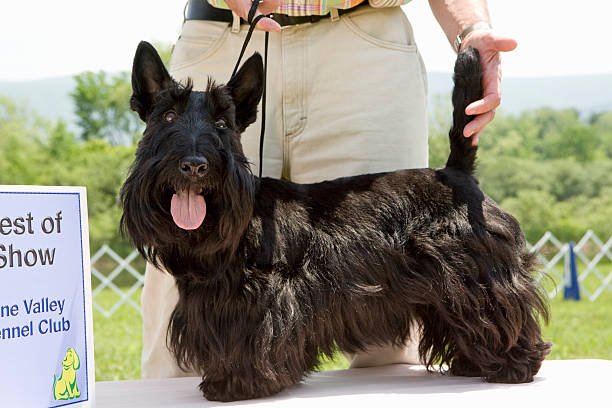
Lucy, my Scottish Terrier, is my confidant, my protector, and my source of endless love. When I first decided to get a dog, I researched various breeds and couldn’t resist the charm of Scotties. Lucy has lived up to my expectations and more.
One of the things I cherish most about Lucy is her loyalty. She’s always been there for me through the ups and downs of life. No matter what, her presence is a comforting constant. She even accompanied me to a difficult time when I moved to a new city.
The grooming process was a bit intimidating when I first started, but with patience and the right tools, I’ve become quite skilled at maintaining her beautiful coat. It’s become our bonding time.
Lucy’s alertness has come in handy on more than one occasion. She’s excellent at notifying me of unexpected visitors, and her presence alone is a deterrent to unwanted intrusions.
The connection I have with Lucy is beyond words. Scottish Terriers have a way of stealing your heart, and Lucy has certainly captured mine.
These personal stories and testimonials from Scottish Terrier owners highlight the unique qualities and experiences of having a Scottie as a beloved companion. They provide valuable insights into the loyalty, independence, and protective nature of the breed, as well as the joy and love that they bring into the lives of their owners.
Cost of Owning a Scottish Terrier
Before bringing a Scottish Terrier into your home, it’s essential to understand the expenses associated with dog ownership. The cost of owning a Scottish Terrier encompasses both upfront costs when acquiring the dog and ongoing expenses for their care and well-being. Here’s a breakdown of the expenses you should consider and the importance of budgeting for your dog’s needs:
Upfront Costs
Acquisition Cost: The initial cost of acquiring a Scottish Terrier puppy can vary depending on factors such as the breeder’s reputation, bloodline, and geographical location. On average, expect to pay between $1,200 and $3,500 for a purebred Scottie. Rescue organizations or shelters may offer more affordable options.
Spaying/Neutering: It’s advisable to spay or neuter your Scottie, both for population control and potential health benefits. The cost of the procedure can range from $100 to $300.
Microchipping: Microchipping is essential for pet identification and can cost around $50 to $75.
Initial Supplies: You’ll need to purchase an array of supplies for your Scottie, including food and water bowls, a collar and leash, a bed, toys, grooming tools, and a crate. These initial supplies can add up to $200 or more.
Training and Socialization: Enrolling your Scottie in a puppy training class is highly recommended. The cost of training classes can range from $100 to $300, depending on the program’s length and location.
Ongoing Expenses
Food: Quality dog food is a significant ongoing expense. Expect to spend around $30 to $60 per month on high-quality dog food. The specific amount depends on your Scottie’s size, age, and dietary needs.
Grooming: Regular grooming is essential for Scottish Terriers due to their double coat. Grooming costs can vary depending on whether you choose to groom your Scottie yourself or use professional services. Professional grooming may cost approximately $50 to $100 per session, every 6-8 weeks.
Veterinary Care: Regular veterinary check-ups, vaccinations, and preventive medications are crucial for your Scottie’s health. Budget around $200 to $400 annually for routine veterinary care. Emergency veterinary expenses can vary widely, so it’s advisable to have an emergency fund.
Parasite Control: Preventive medications for fleas, ticks, and heartworm are necessary. Budget approximately $15 to $30 per month for these medications.
Training and Socialization: Ongoing training and socialization classes may be required to ensure your Scottie’s well-behaved and well-adjusted. Budget around $100 to $300 per year for these activities.
Toys and Enrichment: Scottish Terriers are intelligent and benefit from mental stimulation. Allocate funds for toys, puzzles, and interactive games to keep them engaged.
Insurance: Consider pet insurance to help cover unexpected veterinary costs. Premiums can range from $20 to $50 per month, depending on the coverage and the dog’s age.
Additional Expenses: Be prepared for unexpected expenses, such as unforeseen health issues, travel-related costs, or boarding fees if you need to leave your Scottie in someone’s care.
It’s important to note that the costs provided are estimates and can vary depending on your location, the specific needs of your dog, and your preferences. Proper budgeting and planning are crucial to ensure you can meet your Scottish Terrier’s needs and provide them with the best care possible. Scottish Terriers are wonderful companions, and investing in their well-being is a rewarding experience.
Conclusion
The Scottish Terrier, with its unique appearance, unwavering loyalty, and captivating personality, is a breed that has charmed dog enthusiasts worldwide. From their origins in the Scottish countryside to their roles as family companions and alert watchdogs, Scottish Terriers have a rich history that shapes their distinctive traits.
Understanding the physical characteristics, temperament, and environmental needs of Scottish Terriers is essential for potential owners. Their sturdy build, iconic appearance, and confident nature make them a beloved breed. While their independence and alertness are well-known, their loyalty and loving nature are equally remarkable.
Grooming and maintenance play a significant role in keeping your Scottie healthy and happy. Proper coat care, regular grooming, and dental hygiene are essential. Additionally, maintaining your Scottish Terrier’s overall health requires regular veterinary check-ups and preventative measures.
Scottish Terriers thrive on daily exercise and playtime. Providing them with mental stimulation and socialization is key to their well-being. Training your Scottie using positive reinforcement methods ensures a well-behaved companion.
The historical roles of Scottish Terriers as hunters and vermin controllers have evolved into contemporary roles as cherished family pets and participants in various dog competitions. Their enduring popularity is a testament to their unique combination of traits.
Personal stories and testimonials from Scottish Terrier owners offer insights into the deep bonds and joys that come with owning a Scottie. Their loyalty, independence, and protective instincts are qualities that create lasting connections.
While Scottish Terriers bring immeasurable joy into the lives of their owners, it’s important to be prepared for the costs of ownership. Understanding the upfront costs of acquiring a Scottish Terrier and budgeting for ongoing expenses are essential to provide the best care for your beloved companion.
In conclusion, the Scottish Terrier is a remarkable breed that offers a unique and rewarding companionship experience. Whether you’re captivated by their distinctive appearance, their loyal and loving nature, or their role as protectors, Scottish Terriers have a special place in the hearts of those who appreciate their charm and character.
Grooming and Care for Your Scottish Terrier
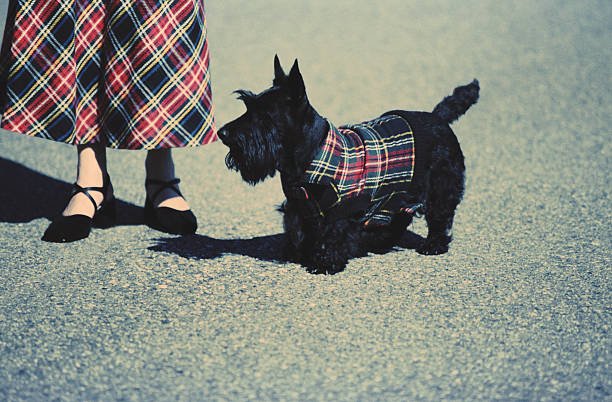
Grooming and care play a significant role in keeping your Scottish Terrier healthy, happy, and looking their best. In this section, we will provide you with advice on grooming and general care, along with recommendations for specific accessories and care products tailored to the Scottish Terrier breed’s needs.
General Grooming Advice
Scottish Terriers have a unique coat that requires regular maintenance to keep it in optimal condition. Here are some general grooming tips:
Brushing and Stripping: Scottish Terriers have a double coat with a soft undercoat and a wiry topcoat. Regular brushing is essential to prevent matting and remove loose hair. You’ll also need to “strip” or hand-pluck their wiry coat a few times a year to maintain its texture and color. It’s advisable to learn the proper techniques from a professional groomer or your veterinarian.
Bathing: Bathing your Scottie should be done as needed. Over-bathing can strip their coat of natural oils. Use a dog-specific shampoo, and ensure thorough rinsing to prevent skin irritation. Brush them before and after a bath to prevent matting.
Ear Cleaning: Clean your Scottie’s ears regularly to prevent ear infections. Use a dog-specific ear cleaner and cotton balls. Be gentle, and don’t insert anything into their ear canal. If you notice redness, discharge, or a foul odor, consult your veterinarian.
Dental Care: Dental hygiene is vital to your Scottie’s overall health. Brush their teeth regularly with a dog-friendly toothbrush and toothpaste. Dental chews and toys can also help keep their teeth clean.
Nail Trimming: Trim your Scottie’s nails every 2-4 weeks, or as needed. Use a dog nail clipper or grinder to avoid cutting too close to the quick. If you’re uncertain about this, your veterinarian or a professional groomer can assist you.
Eye Care: Check your Scottie’s eyes regularly for signs of redness, discharge, or tearing. If you notice any issues, consult your veterinarian. Cleaning the area around the eyes with a damp cloth can help prevent tear staining.
Recommended Accessories and Care Products
Choosing the right grooming tools and accessories is essential for keeping your Scottish Terrier looking their best. Here are some recommendations tailored to their specific needs:
Grooming Tools:
- Slicker Brush: Use a slicker brush to gently remove tangles and mats from your Scottie’s coat.
- Stripping Knife: This tool is essential for maintaining the texture and color of their wiry topcoat.
- Dog Comb: A fine-toothed dog comb is useful for keeping their coat smooth and free of mats.
Shampoo and Conditioner:
- Choose a dog-specific shampoo and conditioner that suits your Scottie’s coat type. Look for products that are gentle and moisturizing.
Ear Cleaner:
- Select a dog-specific ear cleaner to maintain proper ear hygiene and prevent infections. Cotton balls are essential for cleaning.
Dental Care Products:
- Invest in a dog-friendly toothbrush and toothpaste for regular dental care. Dental chews and toys designed to promote oral health can be beneficial.
Nail Trimming Tools:
-A quality dog nail clipper or grinder is a must-have for keeping your Scottie’s nails at the right length.Eye Cleaning Supplies:
- Keep dog-safe eye wipes or a clean damp cloth on hand for routine eye cleaning and maintenance.
Grooming Table:
- If you plan to groom your Scottie at home, consider getting a grooming table to make the process more comfortable for both you and your dog.
Harnesses and Leashes:
- Durable and comfortable harnesses and leashes ensure safe and enjoyable walks with your Scottie.
Toys:
- Invest in interactive toys and puzzle toys to provide mental stimulation and entertainment for your Scottie.
- Crate or Bed:
- A comfortable crate or bed is essential for your Scottie’s relaxation and rest.
Remember that grooming can also be a bonding experience with your Scottie. Regular grooming sessions not only maintain their health and appearance but also strengthen the bond between you and your furry companion.
In the next section, we will discuss exercise and playtime for Scottish Terriers, offering ideas for activities that will keep them engaged and content. These activities are not only fun but also essential for their physical and mental well-being.
Choosing and Adopting a Scottish Terrier Dog Breed
Adopting a Scottish Terrier can be a rewarding experience, both for you and the dog. In this section, we’ll discuss the reasons for adopting a Scottish Terrier breed, how to research and prepare for adoption, the adoption process, and ethical considerations related to breeding and adoption.
Reasons for Adoption
Adopting a Scottish Terrier, or any breed for that matter, comes with numerous benefits and has a positive impact on both the dog and the adopter. Here are some compelling reasons to consider adopting a Scottish Terrier:
Saving a Life: By adopting from a rescue or shelter, you’re giving a dog a second chance at life. You’re providing a loving home to a dog in need, and you’re contributing to the reduction of overcrowded shelters.
Temperament and Behavior: Many rescue dogs, including Scottish Terriers, are well-behaved and socialized. They often come from various backgrounds, including homes, and may already be house-trained and familiar with basic commands.
Health Benefits: Adopted dogs often receive comprehensive health check-ups, vaccinations, and spaying/neutering as part of the adoption process. This can save you money on initial veterinary expenses.
Breed-Specific Rescue Organizations: There are breed-specific rescue organizations dedicated to Scottish Terriers. By adopting through these organizations, you’re more likely to find a dog with the traits and characteristics you love about the breed.
Unconditional Love: Scottish Terriers are known for their loyalty and devotion. When you adopt one, you’ll gain a loving and loyal companion who will be devoted to you and your family.
Satisfaction of Giving: There’s immense satisfaction in providing a loving home to a dog in need. The bond that develops between you and your adopted Scottie is truly special.
Research and Preparation
Before adopting a Scottish Terrier, it’s essential to do thorough research and make the necessary preparations to ensure that you and the dog have a seamless transition. Here’s what you need to do:
1. Understand the Breed: While you may already be familiar with Scottish Terriers, it’s crucial to research the breed’s specific needs, temperament, and exercise requirements. Ensure that a Scottie aligns with your lifestyle and preferences.
2. Financial Responsibility: Be prepared for the financial responsibilities of pet ownership, including food, grooming, veterinary care, and potential emergencies. Scottish Terriers, like any dog, require financial commitment.
3. Living Arrangements: Make sure your living arrangements are suitable for a Scottie. They can thrive in apartments, but they need adequate space and regular exercise. Ensure your home environment is safe and secure.
4. Family Considerations: If you have a family, discuss the adoption with all family members. Ensure everyone is on board with the idea and understands their responsibilities in caring for the dog.
5. Local Laws and Regulations: Check local laws and regulations regarding pet ownership, including breed-specific legislation. Make sure there are no restrictions or additional requirements for owning a Scottish Terrier in your area.
6. Find Reputable Rescues: Research and identify reputable rescue organizations or breed-specific rescues that have Scottish Terriers available for adoption. Read reviews and ask for recommendations from other dog owners.
7. Attend Adoption Events: Attend adoption events or visit local shelters and rescues. This allows you to interact with the dogs, get a sense of their personalities, and find the right fit for your family.
8. Prepare Your Home: Before bringing your Scottish Terrier home, puppy-proof or dog-proof your living space. Remove any hazards, secure toxic substances, and create a comfortable space for your new dog.
Adoption Process
The adoption process for a Scottish Terrier typically involves several steps to ensure that both you and the dog are a good match. Here’s an overview of the adoption process:
1. Application: You’ll start by filling out an adoption application provided by the rescue or shelter. This application helps them understand your lifestyle, living situation, and what you’re looking for in a dog.
2. Home Visit: In some cases, the rescue organization may conduct a home visit to ensure that your home is safe and suitable for a Scottish Terrier. They want to be certain that the dog will have a good environment.
3. Meet and Greet: If your application is approved, you’ll have the opportunity to meet the available Scottish Terriers. Spend time with the dogs to get a sense of their personalities and see if there’s a connection.
4. Adoption Fee: There is usually an adoption fee associated with adopting a Scottish Terrier. This fee helps cover the costs of the dog’s care, including vaccinations, spaying/neutering, and other medical expenses.
5. Adoption Agreement: Once you’ve chosen a Scottie and paid the adoption fee, you’ll typically sign an adoption agreement. This agreement outlines your responsibilities as a dog owner and any specific conditions set by the rescue or shelter.
6. Bringing Your Dog Home: After the paperwork is complete, you can bring your Scottish Terrier home. Make sure to have all the necessary supplies, including food, bowls, a leash, a collar, and a comfortable bed.
7. Veterinary Care: Schedule a veterinary check-up for your new Scottie to ensure they are in good health and to establish a healthcare plan moving forward.
8. Ongoing Support: Many rescue organizations offer ongoing support and resources to adopters. This can be valuable for addressing any questions or concerns that may arise.
Breeding and Ethical Considerations
While adopting a Scottish Terrier from a rescue is a noble and compassionate choice, it’s also important to understand the ethical considerations surrounding breeding. If you are considering a breeder for a Scottish Terrier, keep the following in mind:
1. Responsible Breeding Practices: Choose a responsible breeder who follows ethical breeding practices. Responsible breeders prioritize the health and well-being of the dogs and do not engage in harmful or inhumane breeding.
2. Health Screening: Ensure that the breeder conducts health screening for their breeding dogs to reduce the risk of hereditary health issues. Ask for documentation and verify the health of the puppy’s parents.
3. Genetic Diversity: Responsible breeders work to maintain genetic diversity in the breed to reduce the risk of genetic disorders and promote overall health.
4. Avoid Puppy Mills: Never purchase a dog from a puppy mill, which is a place that mass-produces dogs without regard for their health and welfare.
5. Support Adoption: If you’re considering a Scottish Terrier, always check rescue organizations and shelters first. Many purebred dogs end up in rescues and shelters, and adoption is a compassionate choice.
Whether you choose to adopt or go through a responsible breeder, the most important thing is to provide a loving and caring home for your Scottish Terrier. Your dedication and commitment will ensure that your Scottie enjoys a happy and fulfilling life as a cherished member of your family.
In the final section, we’ll explore the historical and contemporary roles of Scottish Terriers and discuss the competitive events in which they participate. This information will provide a well-rounded view of the breed’s capabilities and contributions.
Frequently Asked Questions (FAQs)
Here are some common questions and answers about the Scottish Terrier breed, addressing various topics not covered in the main sections:
Are Scottish Terriers good with children?
Scottish Terriers are generally good with children and can form strong bonds with them. However, they may have a strong prey drive, so early socialization and supervision around smaller children are advisable.
Do Scottish Terriers get along with other pets?
They can coexist with other pets, including other dogs, if properly socialized. However, their hunting instincts may lead to chasing smaller animals. It’s essential to introduce them to other pets gradually.
How often should I groom my Scottish Terrier?
Regular grooming is important for Scottish Terriers. Brushing their wiry coat at least once a week and hand-stripping a few times a year will keep their coat in good condition.Are Scottish Terriers hypoallergenic?
While no dog breed is entirely hypoallergenic, Scottish Terriers produce fewer allergens than some other breeds due to their low-shedding double coat. They may be a good choice for allergy sufferers.
Do Scottish Terriers bark a lot?
Scottish Terriers are naturally alert and may bark at perceived threats or unfamiliar sounds. Proper training and socialization can help manage excessive barking.
How much exercise do Scottish Terriers need daily
Scottish Terriers require a daily 20 to 30-minute walk, along with playtime and mental stimulation. This helps them stay fit and happy.Can Scottish Terriers live in apartments?
Yes, Scottish Terriers can adapt to apartment living, provided they receive the necessary exercise and mental stimulation. Regular walks and playtime are essential.
What are common health issues in Scottish Terriers?
Common health issues in Scottish Terriers include Scottie Cramp, Von Willebrand’s Disease, patellar luxation, bladder cancer, Craniomandibular Osteopathy (CMO), flea allergies, hypothyroidism, cancer, and gastric torsion (bloat).
Do Scottish Terriers shed much?
Scottish Terriers are a low-shedding breed due to their double coat. However, regular grooming is essential to keep their coat healthy and to remove loose hairs.Are Scottish Terriers easy to train?
Scottish Terriers can be somewhat stubborn due to their independent nature. Positive reinforcement training methods, consistency, and patience are key to successful training.
These frequently asked questions provide insights into various aspects of the Scottish Terrier breed, helping you better understand their characteristics, care, and training requirements.
Conclusion
In this comprehensive guide to the Scottish Terrier breed, we’ve explored various aspects of this remarkable canine companion, from their physical characteristics to their unique temperament and care requirements. As you consider bringing a Scottie into your life, let’s recap the essential information covered in this article and emphasize the importance of responsible ownership and the benefits of adoption.
Recap of Essential Information
- Understanding the Scottish Terrier Breed: We began our journey by exploring the characteristics and history of the Scottish Terrier. This small yet sturdy breed is known for its independent and confident nature, iconic appearance, and rich Scottish heritage. Their loyalty and adaptability make them excellent companions for the right families.
Physical Characteristics: We delved into the Scottie’s distinctive physical features, including their size, head and expression, coat and color, sturdy legs and paws, and their confident posture. These traits contribute to their iconic and dignified appearance.
Temperament Overview: Scottish Terriers possess a unique temperament characterized by independence, confidence, alertness, loyalty, and a protective nature. They make excellent family pets when properly trained and socialized.
Environmental Needs: Understanding the living requirements of Scotties, we learned that they can thrive in various environments, provided they receive adequate exercise and care. Regular exercise, a balanced diet, and proper grooming are essential for their well-being.
Common Behavioral Traits: We explored their behavioral characteristics, such as stubbornness, alertness, occasional barking, and hunting instincts. Proper training and socialization are key to managing these traits effectively.
Popularity and Recognition: Scottish Terriers have maintained enduring popularity due to their unique appearance, loyalty, versatility, and resilience. They are well-recognized by kennel clubs and breed organizations worldwide.
Health Considerations and Care: Taking care of your Scottie’s health is essential. We discussed common health issues, average lifespan, and tips for promoting a longer and healthier life. Regular veterinary check-ups, a balanced diet, exercise, and grooming play crucial roles in their well-being.
Exercise and Activity Recommendations: Scottish Terriers benefit from daily exercise, including walks, playtime, mental stimulation, and socialization. Meeting their exercise needs ensures they remain happy and healthy.
Responsible Ownership
Responsible pet ownership is paramount when considering bringing a Scottish Terrier into your life. Here are some key points to keep in mind:
Proper Care: Ensure that you can meet the breed’s specific care requirements, including grooming, exercise, and regular veterinary check-ups.
Training and Socialization: Scottish Terriers thrive with proper training and socialization. Invest time and effort in helping them develop good behavior and social skills.
Health Maintenance: Regularly monitor your Scottie’s health, maintain a balanced diet, and follow a preventive health care routine.
Grooming: Understand the importance of grooming, including brushing and stripping their double coat, to keep their skin and coat healthy.
Quality Time: Scottish Terriers are loyal and love spending time with their families. Be prepared to provide them with the companionship they need.
Encourage Adoption
While there are reputable breeders, adoption is a wonderful way to provide a loving home to a Scottish Terrier in need. Encourage readers to explore adoption options through local rescue organizations, breed-specific rescues, or animal shelters. Adopting a Scottie can be a rewarding experience, and it gives a deserving dog a chance at a happy life.
In conclusion, Scottish Terriers are exceptional dogs with a rich history and distinctive traits. Their loyalty and unique charm make them a beloved breed among dog enthusiasts. With proper care, responsible ownership, and the understanding of their specific needs, Scottish Terriers can bring joy and companionship to your life for many years to come.




















